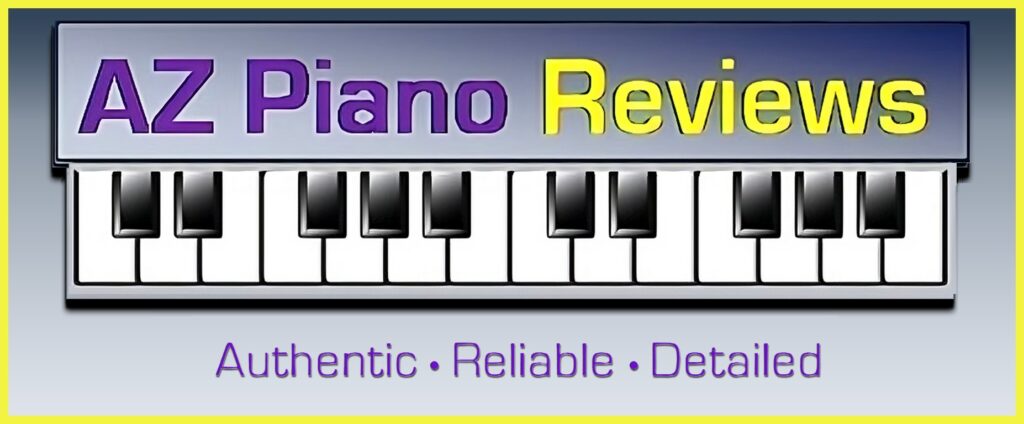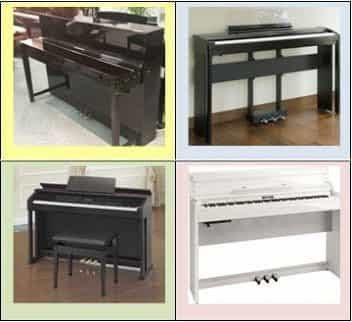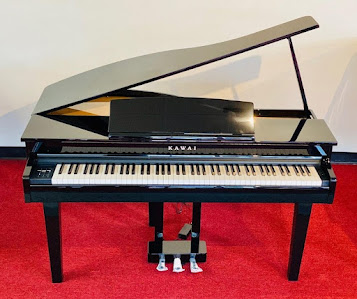REVIEW UPDATE
– Nov 1, 2023 – Roland FP-30X Digital Piano – The Roland FP-30X portable digital piano at $699 internet discount price (stand & triple pedal optional) is the 2022-2023 update of the previous FP-30 which was out for a number of years and is now discontinued. The newer Roland “X’ series portable digital pianos for 2023 consist of the FP-30X, FP-60X at $999, and FP-90X at $1999. The FP-30X and higher priced FP-60X have a lot of similar features but the FP-90X is entirely different when it comes to the actual piano playing experience and it has additional features the FP-60X does not have.FIRST IMPRESSIONS
After playing this new model for many hours (yes, I have actually played it unlike most other reviewers out there who rarely ever play what they talk about because they just make stuff up) I came away from it with a few immediate impressions as compared to the previous model FP-30 (no X).
At first I thought I liked this piano overall and for its $699 price it was definitely competitive in this price range. It had a responsive key action, big, full piano sound coming out of its powerful internal speaker system, a wide and expressive dynamic piano tonal range from mellow to bright depending on how hard you strike the keys, and had long, lush sustain and decay time when using the sustain pedal or holding down a key.
wide and expressive dynamic piano tonal range from mellow to bright depending on how hard you strike the keys, and had long, lush sustain and decay time when using the sustain pedal or holding down a key. 1.
Internal speaker system: Although the internal speaker system is powerful and gives great bass response, the 2 speakers themselves are underneath the piano near the ends of the piano and pointing downward towards the floor. This does not position the sound to come up and out of the piano towards your ears in a distinct and clear manner as digital pianos with upward facing speakers can do. So what happens is that the piano sound is somewhat boxy and distant (although it can get plenty loud) because the sound is going down towards the floor rather than (also) coming up towards your ears. You can hear the sound fine and its got plenty of volume and bass as I already mentioned, but it just feels somewhat removed and closed in.2.
No LED/LCD display screen: On the FP-30X control panel there is no display screen nor was there on the previous FP-30. Why couldn’t Roland have added an updated small display screen on top of the piano and saved me a lot of time and grief? There are many features and functions on the FP-30X (as there were on the former FP30) and when selecting those functions and features its helpful to know what you have selected, so it’s just not very intuitive using the current operating system. You have to press a function button (or another button) and then press certain keys on the keyboard in certain octaves to activate the function/feature that you want. It can be confusing, take a bit of time to figure out, and then when you make the change you don’t really know what you got. With a display screen it can display the name of the function, sound, or feature so you know what you have selected and can be reminded of it when you look in the display screen.If the FP-30X only had a few sounds and functions then a built-in display screen would not be necessary. But the FP-30X has over 50 instrument sounds along with all kinds of cool “bells & whistles” which are just more difficult to access from the piano itself without a display screen and when you do access those sounds and features you usually don’t know what you have or how much of something you have.
Roland actually has a solution to this situation using a tablet/mobile so you can connect your external device such as a tablet to the piano USB output jack and then bring up all the names of the instrument sounds on the Roland proprietary “Piano Every Day” app and easily select them from there.For me I don’t always want to rely on an external device to more intuitively access functions on the piano, plus the app has different pages and areas that you need to navigate through to get to where you want to go. An LED/LCD screen on the piano such as the one in this example from another brand and model would have made the experience so much better and more immediate. The digital piano companies who do the best job with regard to offering a really good intuitive navigation experience of their features and functions in this general price range under $1000 is the Casio with their PX-S3100 and the Yamaha with their DGX-670.
3.
Piano Stretch Tuning: This is a feature that many digital pianos have in trying to recreate the way piano tuners tune real acoustic pianos. When a real piano is tuned, the technician who tunes the piano generally uses a process called “stretch tuning.” In essence this means that the higher octave strings are tuned somewhat sharp and the lower octave strings are generally tuned somewhat flat to even out the frequencies and different pitches the vibrating strings create. This type of tuning allows the piano sound to be more resonate and full and still be in tune when playing various notes together at the same time such as full chords or partial chords. Doing the stretch tuning method in the proper way is critical because if not done right, the piano can sound “out of tune” or “sharp” to some people when playing certain notes or chords together at the same time.In the Roland FP-30X as it was in the former FP-30, the stretch tuning mode is permanent and cannot be shut off…and that’s not a good thing in my opinion. In a real piano if you don’t like the stretch tuning your piano tuner did in the piano, you can have it redone or changed, or just hire another tuner to do it differently so it sounds better to you. But in many digital pianos you cannot change it or shut it off if they have used a stretch tuning method for the general piano tuning of that model.
When I play certain notes together on the FP-30X, especially when one or more of those notes are in the lower octaves combined with playing one or more notes in higher octaves, it sounds like the piano is out of tune or too “sharp” when those notes are played together. In fact, Roland specifically addresses this situation in their owners manual by saying that a person might “perceive the pitch as being incorrect,” but that is the way a real piano is tuned, so it’s normal and Roland says that’s the way a real piano should sound.The problem with that statement is that tuning a real piano using the stretch tuning method is somewhat tricky and if not done right the piano will actually sound “out of tune” or sharp when playing certain notes together, as I just previously described.
In other words, on the FP-30X some notes when combined together as part of a chord (whether the notes are played one at a time or altogether) sound way to “sharp” for my ears. I am not talking about just “regular piano tuning” but the particular process of the “stretch tuning” model that Roland employs in this model. I personally know good piano tuners as well as having played many fine acoustic pianos myself, so I know what a piano tuning can sound like when it is done well, especially for the recreational player.Knowing that Roland has mentioned this “issue” in their owners manual means that they are aware of it, but they suggest that it is the piano owner’s hearing (their ears) and the way they perceive the sound and it is not the fault of the FP-30X.
So in other words…it’s your problem and not theirs. I am here to tell you that although there are people out there who may not be as sensitive to the stretched tuning (sharp notes) in the FP-30X and the prior FP-30 as I am, and they may not necessarily hear it being that “sharp” in a relative way when playing certain notes together, there are other people who are definitely more sensitive to it and definitely hear it.So for me personally, I am disappointed that Roland did not improve the stretch tuning results from the previous FP-30 on this new FP-30X, or at least include an “off position” for the stretch tuning mode so that you can have that option and instantly take out those sharp notes by doing that.
I do expect the stretch tuning for the piano sound to be a little bit sharp on occasion when a variety of notes are played together, but definitely not this sharp and noticeable to where it distracts me from playing it. Just to be clear, all 88 notes sound in tune when played one at a time up and down the keyboard, so that’s not the issue.PHA-4 STANDARD KEY ACTION
The Roland FP-30X graded and piano weighted key action is the same as they had in the previous FP-30 and that key action is called PHA-4 Standard all plastic key action. The PHA-4 Standard is used in 5 Roland digital piano models around or under $1500 and one model that sells for around $2800 called the HP702. So the FP-30X is not the only model that has it.
The white keys on this key action have a synthetic ivory coating on top of them to give it a more of a smooth classic feel and the black keys have a top matte finish that is very nice and feels good under the fingers. Also within this key action, Roland has an “escapement feature” which tries to recreate the notch or slight hesitation why pressing the keys down very slowly about half way.One of the biggest concerns in any key action is how it moves and how light or heavy it might be. What I mean by light or heavy is how much finger force it takes to press down the keys from a key resting position and that is called “down-weight” or “touch-weight.”
In a real acoustic grand piano (and any acoustic or digital piano) the finger force on middle C is measured in grams. The average gram down-weight force on middle C in a good grand piano is about 55 grams or a bit less ) based on my experience with them), and the key action weight for all 88 keys can be set up by a trained piano technician.On the new Roland FP-30X the down-weight force is about 64 grams on middle C and upweight force is about 34 grams based on my measurements.
That’s actually pretty good overall and it’s responsive, although this measurement does make the key action a bit heavier/firmer than a couple other brands out there and definitely a bit heavier than many real acoustic grand and upright pianos I have played. For instance, the Kawai RHC key action in their ES120 digital piano at $949 measures approx 56 grams down-weight on middle C when you lightly press down on the key and about 36 grams for up-weight when the key comes back up based on my measurements. So that key action is lighter and easier to play and that can be important to many people.However, there is a digital touch curve setting on the FP-30X that can be set and adjusted for a quicker sound reaction to the keys going down or a slower sound reaction (when and how much sound comes in) when pressing down the keys, and that feature can help a little bit.
You can set it for light, normal, heavy, etc. But it does not change the actual physical weight of the keys.This PHA-4 Standard key action also has 3 electronic key sensors under each key which can help with giving you a quicker reaction to key repetition.
When you are playing faster pieces of music and the keys are moving quickly, key sensors sense where the key is located at any given moment. Some key actions have 2 sensors per key and others have 3 key sensors per key. Having 3 key sensors is a good thing and can help in key repetition recognition when playing faster or when the key is about halfway down and you are repeating the note at that point. Roland offers the most sensors in this model with 3 of them per note whereas other brands may not have 3 key sensors. So in the case of the FP-30X this PHA-4 key action does a very good job in that way.With regard to key action noise that can occur in digital piano key actions, when the keys are actually moving, some of the key actions out there are physically noisier than others.
When the keys go down and hit bottom then they can make noise or when they are coming back up to resting position then they can make noise that way as well. In my opinion the less noise the keys make, the better, as long as the keys move as much like a real piano as they can without feeling fake or springy. It’s always about realism in key movement vs the noise that the keys can make when moving. In the case of the FP-30X, when the keys go down and hit bottom at a medium speed you can hear a somewhat noticeable thumpy sound, especially when playing the piano at lower volumes or using headphones.THE FP-30X PIANO SOUND
When shopping for a digital piano, the piano sound realism is very important so that you can get good dynamic expression, good smooth tonal changes when playing the keys lightly and increasing velocity by playing with more force, and be able to get
great colorful expression.
To that end the FP-30X does an outstanding job and the Roland FP-30X clearly excels in this way when it comes to dynamic tonal expression. Roland calls their piano technology in this model their “SuperNATURAL sound engine. There are 10 total “acoustic piano type sounds” in this piano with 4 of them being the main acoustic “grand piano” sounds which are labeled Concert, Ballad, Mellow, and Bright.However, I did notice that the 4 main piano sounds were basically the same as the previous model FP-30 in that they are still somewhat metallic and twangy in tone when you are playing with a little more force and you hear the more mezzo forte to forte piano volume start having a brighter and noticeably more metallic tone to the sound, especially in the middle octaves on down where many people play.
When you are playing on those keys lightly then it sounds more mellow and normal and I like it, but when you increase finger force playing the keys and start to put some emphasis on getting out a bigger, stronger sound, the results are not only more noticeable dynamic tonal changes on 3 of the “grand piano” tones, which is a good thing, but at the same time striking the keys harder produces a much more metallic and very bright and twangy tone on the Concert, Ballad, and Bright piano sounds.In other words, when it comes to the overall 4 main piano sounds, 3 of them are very expressive and fun to play but because of having that more metallic tone to them, in my opinion they are much better for pop, country, ragtime, or Latin music, etc and not as useful for classical music, ballads, or softer music because they are just overall too metallic, twangy, and bright in my opinion.
Other people might disagree with me on that assessment but I have played enough Steinway, Bosendorfer, Bechstein, and Kawai (and other good) acoustic grand pianos to know what sounds more “classical” or natural, and to me the FP-30X piano sound engine could be much better in that way.Just to let you know, there is a way on the FP-30X to somewhat mitigate this overly metallic sound. You can go into the Roland Piano Designer app on your tablet and connect to the piano and then you can individually change the “single note character” of the piano sound you are using. You can alter the sound character of specific notes and try to reduce the twangy tone of those notes in that way. It actually does work to some degree if you know what you are doing and have a really good ear to manipulate those individual settings so that it comes out good instead of bad. It can be done but it does not totally eliminate the issues but it can help.
PIANO SOUND POLYPHONY
Polyphony is another item that shoppers look for in digital pianos when comparing one digital piano to another. The general definition for polyphony is the number of notes or “voices” that can be played simultaneously without any loss of notes that are being heard.
The word “polyphony” usually applies more to the acoustic piano sound as opposed to the non-acoustic instrument sounds such as strings, choir, organ, etc. In other words as an example, if you were to combine two or more instrument sounds together and play many notes simultaneously on the left and right hand and also use your sustain pedal all at the same time, all of that uses piano processing memory (aka: polyphony) and that processor needs to keep up with the music you are playing. If it cannot keep up then you will hear certain notes suddenly drop out and stop playing.The FP-30X has 256-note piano polyphony memory which is the most a sampling technology digital piano typically has…and that’s in any price range and from all the brands. So as far as polyphony goes, the FP-30X offers the most in its price range over any other brand out there.
The Polyphony specification is based on whether you are playing stereo piano sounds, mono piano sounds, or stereo or mono instrumental non-piano sounds. Also, the way a sound has been sampled and how many individual sampled parts it has will have a bearing on polyphony.PIANO PEDALS
When it comes to the 3 pedals on a piano and specifically the sustain pedal, that can be an overlooked item especially when you have never or seldom played piano before.
The sustain/damper pedal is actually very important when playing piano and is definitely one of the fundamental things that needs to work well and work correctly so that your piano music sounds good. The FP-30X comes with one square lightweight plastic pedal called the DP2 that is a basic on-off switch. As those inexpensive small plastic pedals go, it’s better than most. The FP-30X is capable of continuous detection variable pedal sustain which can be important to the music you are playing, especially as you become a bit more advanced in your playing skills. When you only have a simple on-off switch sustain pedal then you cannot reproduce what an actual acoustic piano sustain pedal can do. In other words, the basic included pedal will be fine for beginners but because it is small and very lightweight, it will scoot around on the floor when you go to use it and that can be a bit distracting because it never seems to stay in one place.Roland produces an optional and vastly upgraded piano style single metal sustain pedal called the DP-10. Not only is that pedal heavier, longer, and more robust, the bottom of the pedal can grip more easily to the floor and not move around.
Besides the practical side of this much improved pedal, it can trigger the continuous detection/half-damper sustain effect giving you a more natural piano sustain pedal playing experience. The cost of this optional DP-10 pedal is $54.99 plus tax and personally I think this pedal is a “must” for anyone using a single damper pedal on a Roland portable digital piano. So in my opinion you should definitely add that cost onto your purchase. The Kawai ES120 digital piano at $949 which competes with the Roland FP-30X already comes with a heavy duty single sustain pedal which can trigger the amount of variable sustain/decay that you get when pressing down the pedal so there is no need to spend extra money on that model. Roland should have done the same thing but they didn’t and left that expense to you.Roland also has an option furniture triple pedal unit available which gives you all 3 pedals including sustain, sostenuto, and soft pedals and the sustain pedal portion of that triple pedal unit also triggers the variable sustain effect.
The triple pedal unit can also be programmed for 2 of the pedals to trigger specific functions on the piano by pressing down one of those pedals so you don’t need to trigger the functions with your fingers on the piano itself. You would need to connect the triple pedal unit directly to the optional furniture stand that Roland produces for this model or the triple pedal unit won’t work and be secure. The triple pedal unit is priced at $130 and the optional furniture style stand is priced at $150. But as far as the physical sustain pedal goes, any of the pedal options will work but in the long-run the optional DP-10 pedal is best if you don’t need the furniture stand and triple pedal setup.PEDAL SUSTAIN-DECAY TIME
As for the piano sound when sustaining that tone, when you hold down the piano the piano sound is supposed to be big and full and the sustain-decay time should be long and fluid with good sustained volume as well.
In some digital pianos out there the sustained tone and sustain length of time is not very good with lowquality sustain and only lasting a short amount of time. With the FP-30X, the quality and quantity of the sustained piano sounds are excellent and far better than most of the other portable digital pianos out there, especially under $1000. The sustained piano tones are lush, big, full, and resonate, and they are balanced well from lower to upper octaves. when notes are played together as chords. You can even hear some of the sympathetic vibrations from the piano sounds as they are sustaining. The sustain-decay time on measured on middle C is about 12 seconds when the sound fades out as you are holding down the pedal, and that’s a fairly long time for a digital piano in this price range. The sustain time is longer on lower octaves and shorter on higher octaves and that’s typical of all pianos in terms of lower and higher octaves and the amount of sustain you can get. The Roland FP-30X is a winner in this area and I like it very much.
INSTRUMENT SOUNDS
Ok, now we’re going to get off the piano parts of this instrument and onto the other stuff. There are 46 (non acoustic piano) instrument sounds in this instrument including harpsichords, organs, electric pianos, strings, brass, harp, choirs, synthesizers, voices, jazz scat, guitars, and bass.
Other than the competitive Casio PX-S3100 at $879 and Yamaha DGX-670 at $849 having many more instrument sounds, the FP-30X has the most non-piano instruments in its price range. Those instruments also happen to be very good, many are in stereo, and they are a pleasure to play either by themselves or in combination layered with another sound. I really like the string and brass tones along with authentic sounding harpsichords and harps. The synth and pad sounds are also great and fill in nicely when layered with a grand piano sound. Also, I love the jazz scat vocal sound and this setting gives you many velocity triggered voices just like an Acapella jazz vocal group and Roland has had this sound proprietary sound out for many years in a number of its digital pianos and it is definitely one of my favorite sounds to play with…definitely fun stuff.To select all these instrument sounds you only get 3 sound category buttons on the piano control panel to do that which include the piano category, electric piano, and other. But within the piano category there are also harpsichords and within the electric piano button there are organs, and within the “other” category there are a variety of strings, pads, synths, and others. This is definitely not an intuitive way of selecting sounds especially when you have to look at the owners manual or memorize where that one sound is located that you want to use by pressing a function button and the correct black or white key at the same time to get that sound. What a mess…I definitely am not a big fan at all in the way you access these instrument sounds. Why not just add some more category buttons to make life easier? But even then you still have to “guess” where the sound is accessed on the keyboard to get it.
So it is real important to use the Roland Piano Every Day app on a tablet or phone so that you can much more easily access these different instrument tones and know what you are actually getting, and you can do it using a specific category that coincides with the sound which is the way it should have been on the piano. By the way, many of the actual instrument sounds themselves are really good and produce a big, natural sound such as the strings, choirs, synths, and organs among others as I mentioned earlier. Some of the electric pianos are also very good and have a wide and very smooth dynamic tonal range on the vintage Rhodes electric and Wurlitzer electric as well as for the vintage DX7 electric piano/keyboard sound. The phaser (effect) electric piano is also very impressive and fun to play with lots of musical color in it. However, there is not a separate chorus effect independently applied that I would liked to have seen on this model.
Besides the proprietary instrument and piano sounds in this model, it also has the full set of General MIDI instrument sounds which are additional instruments, sounds, special effects, and percussion not accessible from the front panel of the FP-30X, so you would never know they exist in this piano.
To access these additional 100 plus sounds you need to do that from the proprietary app on your iPad or android tablet or phone that I mentioned earlier called “Piano Every Day,” which I will talk about more later. The 100+ General MIDI instrument sounds include more pianos, more strings, brass, woodwinds, guitars, choirs, etc, etc, but the sonic quality is not as good as the proprietary FP-30X instrument sounds, but they are still fun to have. So not only do you get all of the main instrument sounds I mentioned, but you can access the General MIDI sound bank from the Roland app on your color touch screen in your external device.EXTRA “BELLS & WHISTLES”
As far as “bells & whistles go, the FP-30X has a lot of them but you wouldn’t know it from just looking at the control panel.
Even though you can access some of these extra functions and features from the panel, as I mentioned earlier near the beginning of this review, since there is no digital display screen it can be difficult to tell where things are or what you did when you made a change. Nevertheless, the FP-30X does many extra things such as having the ability to layer/mix any 2 instrument sounds together and it can split any 2 instrument sounds with one on the left hand and one on the right and you can set the split point of the keyboard. Most all digital pianos now have a function that let’s you digitally split the 88 keys into 2 equal 44-note keyboards so that 2 people (mainly for students) can play the same notes sounding in the same octave at the same time. It’s a way for 2 people to practice the same music at the same time and Roland calls it “twin piano.”RECORDING & PLAYBACK FEATURES
The FP-30X has a 3-track MIDI recorder and playback system which can hold about 70, 000 notes as opposed to the previous model that could only record one MIDI track.
This new model can also playback audio wav and MP3 files from a USB flashdrive which is very cool along with playing General MIDI song files as it has the General MIDI sound set like the previous model did. Therefore you can download songs off the internet in the GM format and transfer those files to a thumb-drive and then into the FP-30X for full multi-track instrument playback…and it really sounds good. There are MIDI song files for all types of music so this can be a useful feature tohave.
OTHER USEFUL FUNCTIONS & FEATURES
Other things the FP-30X has are special sound effects that can add to the realism of certain instrument sounds such as acoustic pianos, organs, electric pianos and a few other instruments. Those effects include ambience/reverb, rotary speaker effect, and modulation speed for electric pianos.
You can adjust the depth of those effects from the piano although it is much easier to do on the Piano Every Day app. This would also include the transpose key-change feature which allows you to modulate to other keys without changing your playing position. This is particularly good when singing along with a song because that song may be out of your vocal range, so being able to digitally change keys up or down can be very useful in a number of ways. This model also has touch sensitivity controls so that you can digitally change the sensitivity of the keys from a lighter touch up to a heavier touch. As I previously mentioned, this does not physically change the key weight but is does change how sensitive the piano sound is and how quickly the sound comes in when the keys initially go down.BLUETOOTH WIRELESS STREAMING
The previous FP-30 had some good connectivity in it and the new FP-30X has added seven more new features that I have been hoping to see for a while. The 30X already has Bluetooth wireless MIDI to connect wirelessly to external devices to control MIDI related apps and content.
But now Roland has added Bluetooth wireless audio so that you can stream music from your external device into the Roland piano coming out of the stereo piano speakers which essentially turns the FP-30X into a home stereo speaker system. This is especially useful if you are standing somewhere else in the room and want to hear music from your phone or tablet come out in a bigger way. The Bluetooth audio feature works good and the FP-30X definitely puts out a big, full volume in that way. There is still a bit of an issue with the fact that the internal piano speakers are under the piano pointing downward as I previously mentioned which makes the audio streaming music being heard still somewhat boxy and restricted, and it is more noticeable if you are at or near the piano itself. If you are in another part of the room than it really doesn’t matter. Again, I wish Roland had included top speaker ports on this new model to give the sound more clarity and directional movement towards your ears instead of away from them, even if it slightly raised the cost of this piano.USB WIRED AUDIO STREAMING
Another technological connectivity feature that I really like and feel all digital pianos should have (which many don’t) is USB wired audio streaming from an external device and directly into the piano speakers when using an app in real time.
This is different than Bluetooth because Bluetooth is a wireless technology whereas USB audio streaming uses a standard USM/MIDI cable to transmit the audio signal in real-time. With Bluetooth, the audio signal is delayed a fraction of a second coming from an external device into the piano so that it is not practical for live real-time music and instrument apps when playing the piano live. To hear additional audio and instruments from an external device when you are playing on the FP-30X keyboard and wanting to trigger sounds on an external app such as the popular Garage Band, you need immediate audio transfer without latency or delay. Since Bluetooth cannot do that then you need either an audio input jack on the piano along with an audio output jack on the external device or you need the simpler and better USB audio streaming.The FP-30X has this newer USB audio streaming so you can have instant audio coming into the FP-30X, especially if you are using apps with additional instrument sounds or learning software that requires you to follow along with lessons.
In this way the Roland FP-30X does a great job and it is extremely useful for all the ways I mentioned. You just need a standard USB cable along with the proper accessory connector to the device (iOS would require a lightning camera kit) and then you’re all set. This type of connection allows you to add on sounds and effects to the FP-30X (or any digital piano with USB audio streaming) such as what you would get when using Apple Garage Band, etc. So this particular “bell & whistle” is a very practical feature and I am happy that Roland has it on this model.HARDWARE CONNECTIVITY PORTS
The hardware connectivity features in this model are also good including a USB output to external device, USB input port for thumb-drive so that you can play MIDI and audio files through the piano, 2 stereo headphone jacks for private practice including a mini jack and and a standard 1/4″ jack, and the newest addition being 2 standard 1/4″ audio line output jacks.
The line out jacks (or the lack of them) in the previous model was a very sorepoint for this piano and a big headache for people who owned the previous FP-30 and used it for “gigging” purposes or bigger events where an external speaker system was needed. There was no easy and practical way of connecting additional sound systems, so this time Roland (finally) got smart and included these standard audio connector jacks on the back of the FP-30X and now all is good. You can easily connect your external sound system or nearfield speaker monitors to this piano without the hassle of the previous model. There is no separate audio input jack or microphone input jack on this model. Some people may have wanted one or both of those jacks but the FP-30X does not support them.
INTERNAL SPEAKER SYSTEM
The internal speaker system of the FP-30X is definitely a good one in terms of power and bass response and it’s easy to immediately tell how good it is just by listening. The audio power is 22 watts total going into 2 smaller 4.7″ speakers so by itself the speaker system is pretty good.
But what gives it the extra bass and volume boost that it has is the fact that Roland has increased the size of the area where the sound resonates inside of the piano and the previous model was the same way. If you look at the outer case area in front of the piano keyboard you can see that the bottom area of the piano is much deeper than other digital piano pianos. In fact it measures about 2.5″ deep in extra depth (height) as compared with other brands and models of portables measuring in at about 1″ in “extra” depth (height) from bottom to top of piano. In other words Roland has more inner compartment for the sound to resonate in as compared to other portable digital pianos which adds extra depth and bass to the sound and that design really helps a lot…and I like it.But what Roland did not do with the internal speaker system is take it to that next level and add top facing speakers so it could better project clarity and be a lot less internalized and boxy with the sound pointing down to the floor. However, Roland’s next model up called the FP-60X has those top facing speakers so that issue is not present on that model.
If you don’t mind going up to the next price level at $999, for about $300 more, the newer FP-60X offers big upgraded benefits and features and is more than worth the additional cost over the FP-30X in my opinion.ROLAND APPS – PIANO EVERY DAY
Before I get to the last couple of things with the FP-30X I want to briefly talk about the external proprietary apps that Roland has created for this and other Roland digital pianos models, and those apps are called “Piano Every Day” and “Piano Designer.”
Piano Every Day is the “controller app” for the FP-30X using either iOS or Android devices (best for tablets) where you can control many (but not all) of the features of the FP-30X from your color touch screen on your device. These features and functions include accessing the instrument sounds, layer and split functions, volume controls, transpose and brilliance controls and other functions.The 1st thing that most people would want to use is the instrument sound navigation chart inside the Piano Every Day app. There are 9 categories of instrument sounds that you can access in the app including Piano, Electric Piano, Organ, Strings, Pad, Synth, Other, Drums, and GM2 (General MIDI sounds).
Once you select the instrument category you want then you select the specific instrument sound in that category and the the FP-30X will be instantly setup for that sound. For instance, in the Piano category there are 10 acoustic type pianos and 2 harpsichord sounds for a total of 12 sounds. Harpsichords have strings and keys like a piano so Roland included those 2 harpsichords in the Piano category so when you go to the list of pianos you will also see those 2 harpsichords. The list of those sounds are easy to access activate and work very well. The Piano Everyday app for all functions can only be used in the portrait position and not landscape position, unfortunately, probably because of the way they had to design and build this particular app. But that’s OK because it still works good although I would prefer to have my choice of display positions.Besides controlling the proprietary instrument sounds on the FP-30X, the Piano Every Day app also lets you access other features not built into the piano, so without using the app you would not have access to these features that can add more enjoyment to your music.
One of those items is the General MIDI instrument sounds that I previously mentioned. There are well over 100 additional instrument sounds including more and different electric pianos, acoustic pianos, strings, percussion, bells, etc. So if you are the type of person who thinks they would like many more instrument sounds and sound effects, then the Piano Every Day app will certainly do that for you and you just access those instruments live through a long list within the app and you can also layer and split those sounds as well. Those GM sounds also are the ones used automatically when playing GM MIDI song files from a flashdrive because without those sounds you would not be able to play GM song files.The Piano Every Day app also allows you to access and use interactive music style rhythms that play through the FP-30X in real time as if they were built into the piano when you play some chords but they are actually in the app. Those music styles include rock, jazz, Latin, country, waltz, etc, etc. and are useful when playing chord driven rhythmic music
There are 21 of them and the tempo and volume of each style can be controlled along withstyle variations, intros, and endings. All of the rhythm features are on your tablet touch screen so you just access them from there. You can also use any of the 21 rhythm styles to just their drum patterns so that you can have a drummer play along with your music as opposed to using all the instruments in the band. There’s a lot of flexibility in that rhythm style feature but to make it work well you really need to play chord style and not do traditional bass-treble clef music because it just doesn’t work as well that way.
The Piano Every Day app also offers a very cool visual digital metronome for rhythm and timing training for students.
This is helpful to visually see the timing of your music and be able to better stay with the beat through visual as well as audible training. There are also various time signature settings available and lots of flexibility within this portion of the app. I will also say that there are some very good 3rd party visual metronome apps in the app store that can be used with any digital piano and in some ways those apps offer even more useable training features than what this app has to offer. So the Roland Metronome feature in the app is not the only game in town, but it’s within their app so it is definitely more convenient that way. The piano itself also can access the metronome feature and then you can hear the metronome counting off the beats and timing, but you don’t “see” the metronome so there is no visual aspect that way. It’s always easier and better to see the metronome moving as well as hearing the beats click to the timing you have set.On the Piano Everyday app you can also access a big library of songs with built in sheet music for those songs and then play along with it for learning and this can come in very handy if you are able to do that type of practicing and the app even keeps up with your daily/weekly practice and can save practice info within the app.
The library of songs includes simple kids music such as “twinkle twinkle little star” along with classical piano music. With some of the non-classical music like “twinkle twinkle” or “Greensleeves” as examples, there is an orchestral accompaniment track that adds orchestral instruments and percussion to the piano parts which makes that song sound bigger and more exciting and also makes you sound better than you really are as you play along using the piano. You can mute the accompaniment track if you don’t want it as well as either the left or right hand piano parts and also slow down or speed up the tempo of the music as it is playing.ROLAND APPS – PIANO DESIGNER
The other proprietary app that Roland offers is called “Piano Designer.” Piano Designer has been out for a number of years and works on nearly all of their digital pianos although you would use the settings and features for the specific Roland piano you are using assuming you set it up that way.
Every Roland digital piano has their own settings and their own controls on this app. The Piano Designer app is actually pretty cool because you can get into more of the piano sound organic elements and customize them to your liking assuming you would want to do this. Thesespecific areas of the piano sound include lid, string resonance, damper resonance, key touch, key off resonance, single note tuning, single note character, and single note volume. You can control those individual aspects of the piano sound and increase or decrease the amount that you want of each one.
CONTROL PANEL
The control panel on this model is simple with small rectangular rocker buttons that click and light up when you push them down so you know that you can tell when you have pushed them and they are activated.
The buttons line up above the keys near the 2 lowest octaves in a button pattern of 1 button, then 2 buttons near each other, then 1 button, then 4 buttons near each other which are the instrument sound group buttons and split button, then 3 buttons which are the metronome and metronome speed buttons, and then 2 buttons which are the play & record buttons. The buttons mostly light up in an easy to see white color, the function button lights up blue, and the record button lights up red so that you can visually tell the difference. There are 5 small flush mounted white LED lights about the volume buttons so that you can visually see when you have increased or decreased the master volume and they work good.Just above the keys under the control panel are printed indictor words for some of the functions within the piano so that you can control them using the function button and then pressing a specific keyboard key to activate that function and change it.
For instance you can access the transpose feature and changing keys thatyou play in by holding the function button on the control panel and then pressing a specific white or black key corresponding to the key you want to be in which will then change the key lets say from C to C# or to F, etc. This way of digitally changing keys is not too bad but the light silver printing of those names just above the keys is not easy to see, especially when playing in a darker room. The same goes for brilliance, ambience, and other functions that you can access in this way.
FP-30X CABINET
The FP-30X is a portable digital piano but with the optional KSC70 furniture type stand and KPD-70 triple pedal unit you can make it look more like a small piano, although it does not have a key cover like traditional cabinet pianos do.
When you add the cost of the triple pedal and furniture stand to the cost of the piano the total price would be approx $1027. This piano also comes with a detachable music rest so you have a place to put your music. The piano itself measures in at about 51″ wide x 11″ deep x 6″ high and its weight is just under 33 lbs so it’s not as light as other portable digital pianos in this price range which weigh in at about 26 lbs, but it is still light enough for many people who need to carry it around. The cabinet itself looks great with tapered and rounded edges and a smooth matte finish. I like the white color cabinet finish as well but the black finish (on any digital piano) is definitely more popular.FINAL THOUGHTS
As I have already stated, I am not a big fan of downward facing speakers under the piano if there are no top facing speakers along with them as is the case with the FP-30X.
The overall volume and bass response is amazing for the piano’s smaller size, but it just sounds too boxy and closed in for me. Adjusting the “brilliance” function to add more brightness to the sound does help bring more clarity to the sound and give it some lift. But then the entire piano sound sample is just too bright and twangy at that point for my tastes when you do that, so it really doesn’t resolve the issue with the speaker placement or the fact that Roland did not add a couple of top facing speakers. However, with that being said, you may like the way it sounds because it is certainly loud enough and big enough in terms of volume and sound and for many people who don’t have experience with a real piano or are not as picky about sound projection or perhaps will be using headphones most of the time, the FP-30X may still be great for your ears and expectations.The lack of a display screen in this model is also another issue for me and I really was hoping that Roland would include on in this new upgraded model, but they did not.
You’ll need to move up to the $999 FP-60X model to get it but as I mentioned earlier, I think the FP-60X is a much better buy for the money over the FP-30X for that reason along with other reasons such as upward facing speakers. A display screen just really helps to quickly navigate the functions and features of the piano in a much more intuitive way and also help to see what’s going on with your piano in a darker room as well. Yes, I can make my way around the piano with the navigation functions they have and by also using their apps, but I might not want to do it that way.As for everything else this piano does, it really is pretty impressive. From the quality and quantity of the instrument sounds, to the connectivity features, to the big bold internal speaker system as far as bass and volume is concerned, to the feature rich apps that Roland supplies for this model and all the things you can do with them, the FP-30X offers a lot.
The key action is also overall enjoyable to play and very responsive, although I personally prefer a somewhat lighter key action more like the weighting of a real acoustic grand piano. The Roland company makes very reliable, robust products that many pros and studios around the world use. Their factory warranty on this piano is 3 years parts and 2 years labor. Based on all my years of experience playing Roland digital pianos and keyboards it is very unlikely it will need service be they are very dependable products and well made.By the way, considering that the FP-30X with stand & triple pedal unit is a bit over $1000, a few other good alternatives would be the popular Casio PX-870 at $999 (with $200 instant rebate) and the newer Korg LP-380U at $999 (with current $350 factory rebate).
Also, there is a very impressive new portable digital piano by Kawai called the ES120 at $949 and the new 2023 Casio PX-S5000 at $1199. You should definitely check that one out as well. If you don’t need the piano to be “portable” and you don’t need or want as many “bells & whistles” as the Roland FP-30X has, the Casio and Korg pianos would be very good choices as they both have internal speaker systems that are much more powerful at 40 and 44 watts respectively and also speakers that direct the sound towards you. Both of these models are focused more on piano playing and don’t have near as many instrument sounds, no rhythms, no Bluetooth wireless audio, etc.If you want more info on new digital pianos and LOWER PRICES than internet discounts, please email me at tim@azpianowholesale.com or call direct at 602-571-1864.













































































Wow, that's quite a detailed review and I thank you for it. I've recently purchased an FP30X after pain staking research over months. Very interested in the tune stretching points you put forward. Can't say I've noticed it yet. Downward firing speakers are not good and I was deeply suspicious of this before purchase – they create a duller and hollow sound – looking to use the line outs to hook up something at face level for more colour, balance and clarity. I wouldn't swap my Kemble upright for any electric substitute, but wanted an alternative for late night and early morning practice and just messing about. FP30X will do that for me.
Thanks again,
Dave S (London UK)
Thank you for the great review. Do you prefer the pha4 standard action to Korg's rh3 action?
Thats all the info one would ever need to make a purchase decision. Very detailed review. Thank you.
Thank you very much for the detailed review!
Thank you for your very detailed review. Lots of information and things to consider.
Thank you for your honest and detailed review, the best I have found! I am so glad that you mentioned the stretch tuning issues because I own an older Roland and the out of tune sound when playing chords is driving me nuts. Nobody else mentioned this in their reviews. I am very picky about out of tune instruments (classical guitar player here). I was not sure if this still is a problem in the FP-30X. So your review helped me not to upgrade to the FP-30X. I think I will buy a Kawai ES 520. Thanks from Germany!
What would you recommend as a solution for fixing the stretch tuning of the FP-X30? Are there particular tuning settings in the Piano Designer app that sound better? Any advice would be appreciated.
Thanks Tim,
With a nice pair of 20 W or 40 W speakers, this keyboard really shines. Although I understand your concerns over the stretch tuning, I actually like it, and I find it more convincing than others I’ve heard. In any event, almost all low cost home digital keyboards get a boost from a set of speakers. Also love the action, it helps casual players achieve accuracy. I have no issues with navigation, but am in the minority.